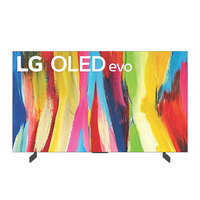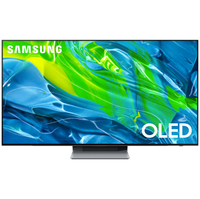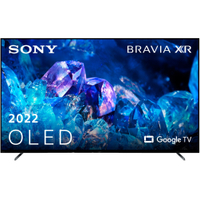TechRadar Verdict
The Philips OLED807 remains a gloriously eye-catching reminder that there’s plenty of life left in traditional OLED technology yet, despite QD-OLED trying to steal its thunder. It's especially great for AV fans who don’t have limitlessly deep pockets but want stunningly cinematic images, with bonus next-gen gaming support.
Pros
- +
Premium, Ambilight-bolstered design
- +
Outstanding picture quality
- +
Good value for what’s on offer
Cons
- -
Needs tweaking for best results
- -
Complex menu system
- -
Occasional subwoofer crackle
Why you can trust TechRadar
Philips 55OLED807: Two-minute review
The Philips OLED807 is the latest mid-range OLED from the company, and it hits the ground running with its design, which finds its incredibly thin screen and high-quality metallic finish offset to spectacular effect by Philips’ Ambilight technology. This uses rear-mounted LEDs to cast coloured light onto the wall behind the TV that can match the pictures you’re watching with uncanny accuracy, making the picture feel even bigger and more involved than just the set can manage.
If anything, though, the Philips OLED807’s picture quality is even more eye-catching than its design. It uses one of OLED manufacturer LG Display’s latest EX panel designs, which is claimed to deliver up to 30% more brightness than regular OLED panels, and it pushes this panel hard with Philips’ latest picture processing engine. The result is some of the most vibrant pictures among the world of the best OLED TVs, even if it's less bright than the most expensive options.
The Philips OLED807 is a great option for gamers, too, thanks to its support for 4K 120Hz signals, variable refresh rates and automatic low lag mode switching, while its picture quality glories are supported by an audio performance far more powerful than you’ve any right to expect from such an elegantly slender TV.
Add to all this a good implementation of Android TV 11’s smart TV system and it’s hard to see what more you could really ask for at the OLED807’s price. The LG C2 can give you more gaming support and less setup time for its best pictures at the same price… but it's weaker in sound, not as nice-looking and lacks the glorious Ambilight. The Samsung S95B is brighter still at the same price, but its pictures are less refined, and it lacks Dolby Vision – and doesn't sound as good. You can swap priorities from what the OLED807 offers when you look at other TVs, but it's always a trade off, not an outright improvement.
We tested the 55-inch Philips 55OLED807 for this review.
Philips OLED807 review: Price & release date
- Released in July 2022
- From £1,199 for 48-inch model (not in US or Aus)
- Available in 48-inch, 55-inch, 65-inch and 77-inch sizes
Despite boasting a design and features list that look like they should belong to a seriously expensive TV, the OLED807 starts from very reasonable prices in the UK. Unfortunately, though, TP Vision, which operates the Philips TV brand in the UK, does not operate Philips TVs in the US, so you won’t find the OLED807 on sale there. Nor, at the time of writing, can you find an OLED807 on sale in Australia; Philips doesn’t appear to have updated its range there since 2020.
The 48-inch OLED807 costs £1,199, which is actually a little on pricey side. However, the sweet spot here is the 55-inch model, which we tested, and costs £1,299. The 65-inch version costs £1,899, while the 77-inch model costs a robust £3,499.
The OLED807 is actually up against some pretty stiff OLED competition – in the case of the 55-inch model, for example, you've got LG’s £1,299 OLED55C2, Panasonic’s £1,349 TX-55LZ980B and, most awkwardly of all, Samsung’s £1,299 55S95B. Why is the latter, recently heavily discounted model potentially especially awkward? Because it uses new Quantum Dot OLED technology, with its pure RGB colours (traditional OLED TVs add a white element to the mix). Will the Philips OLED807 really be able to hold its own in such illustrious company?
Note, finally, that stepping up to the next tier of Philips’ 2022 OLED story, the 55OLED907, with its Bowers & Wilkins audio system and additional brightness-boosting heat sink element, will set you back £700 more.
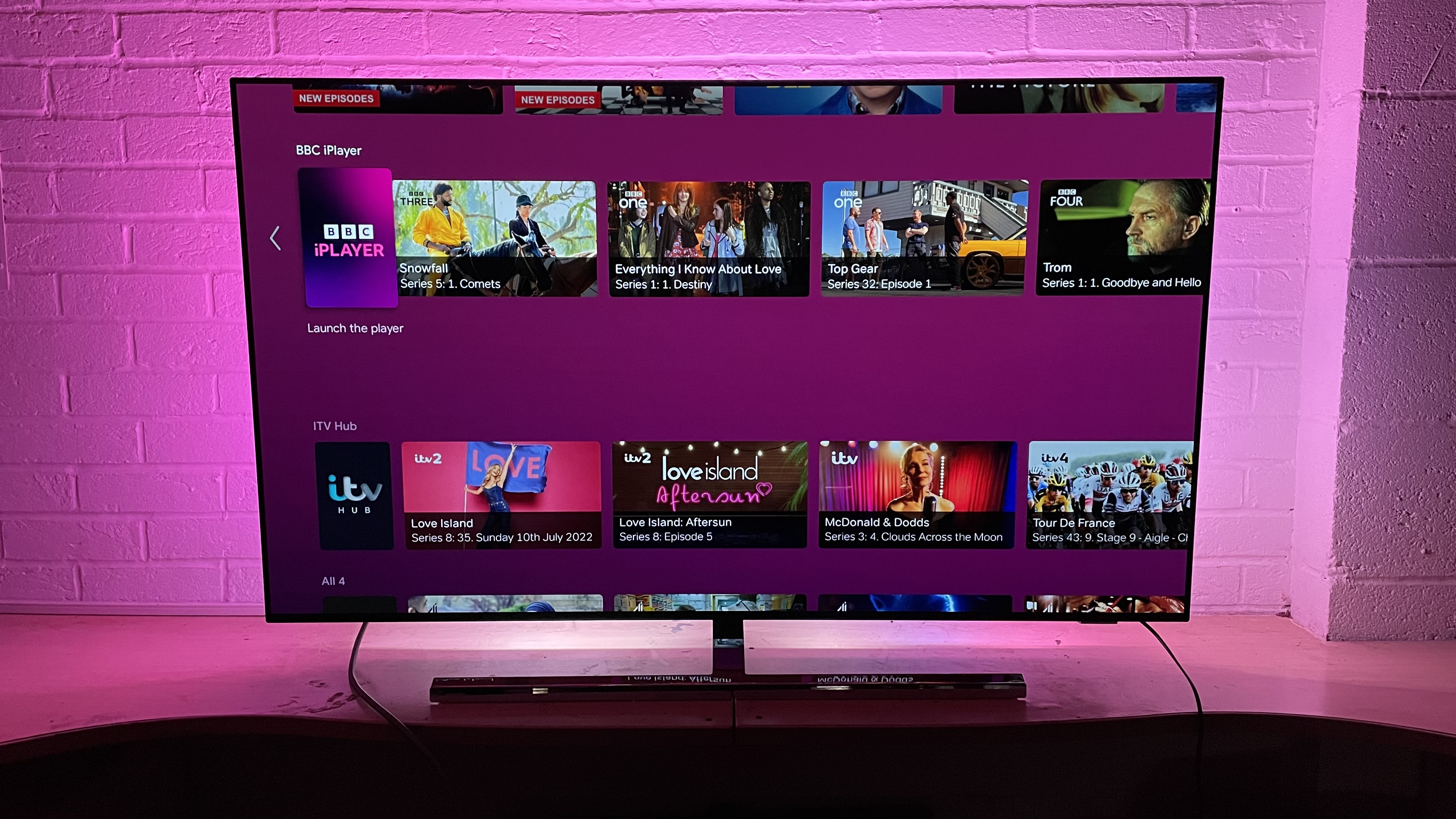
Philips OLED807 review: Features
- OLED TV with brighter EX panel
- P5 Gen 6 picture processor
- Wide-ranging HDR and gaming support
As ever with an OLED TV, every pixel in the OLED807’s screen can produce its own light, delivering massive local contrast benefits over even the best LCD TVs. The OLED panel in the OLED807, though, builds on this by being one of the latest so-called OLED EX displays, meaning that it has the potential to produce as much as 30% more brightness than many previous OLED TVs. It's a big deal in these days where HDR video is so widely available.
Driving this new grade of panel, meanwhile, is a new version of Philips’ P5 picture engine. Previous generations of this system, which applies dozens of separate processing elements to five core picture elements (contrast, colour, motion, sharpness and source detection) have already eked out levels of peak brightness that have eluded OLED rivals. In combination with the OLED EX panel, it's quite a spectacle.
The new generation of the P5 processor extends its AI-based content classification feature with a new Auto Film mode, and there’s also a new Ambient Intelligence features that applies sophisticated machine learning techniques to adjusting various aspects of the picture in response to ambient light conditions.
The sensor used for this Ambient Intelligence feature also helps the OLED807 deliver the HDR10+ Adaptive HDR system, which adjusts playback of content mastered in the HDR10+ HDR format to suit room light conditions. This HDR system sits alongside the more regular HDR10+, HLG, HDR10 and Dolby Vision formats. Such comprehensive HDR support is still rare in the TV world, with many rivals only sporting either HDR10+ or Dolby Vision, not both. Philips’ admirable HDR format neutrality means the OLED807 will play the best version available of any source material presented to it, unlike the LG C2, Samsung S95B or even the mighty Sony A95K.
The OLED807 has also been awarded IMAX Enhanced status, meaning IMAX has deemed the TV good enough to do justice to streamed films and 4K Blu-rays mastered using the IMAX Enhanced system. Plus there’s a Filmmaker Mode picture preset that’s been designed in conjunction with the UHD Association to deliver accurate pictures that track the standards used by the film industry.
We could spend a good few thousand words next on the myriad picture adjustments provided within Philips convoluted menu system. It really does feel like Philips has given you control over, well, everything. For the sake of everyone’s sanity, though, we’ll limit ourselves to saying that while enthusiasts may embrace and enjoy exploring the huge range of adjustments the 55OLED807 carries, it can all be a bit intimidating to more regular folk.
You get Android TV as your smart software here, but note that it isn't Google TV – unlike Sony, Philips hasn't moved on yet. This is disappointing in terms of usability (Google TV is superior to Android TV for ease of use), but when it comes to how comprehensive the streaming support is there's little to criticise here.
Gaming is supported by two HDMI 2.1 ports (in addition to two HDMI 2.0 ports), with support for 4K 120Hz and Variable Refresh Rate, plus Auto Low Latency Mode so it switches to its Game Mode when you fire up a console.
There's Dolby Atmos decoding built-in, and HDMI eARC support for connecting to one of the best soundbars.
And there's Ambilight. This unique-to-Philips technology spreads light that matches what's on-screen across the walls, making the TV feel even bigger, and helping with eye comfort and atmosphere. We'll talk more about it later, but it really is a compelling addition.
- Features score: 4.5
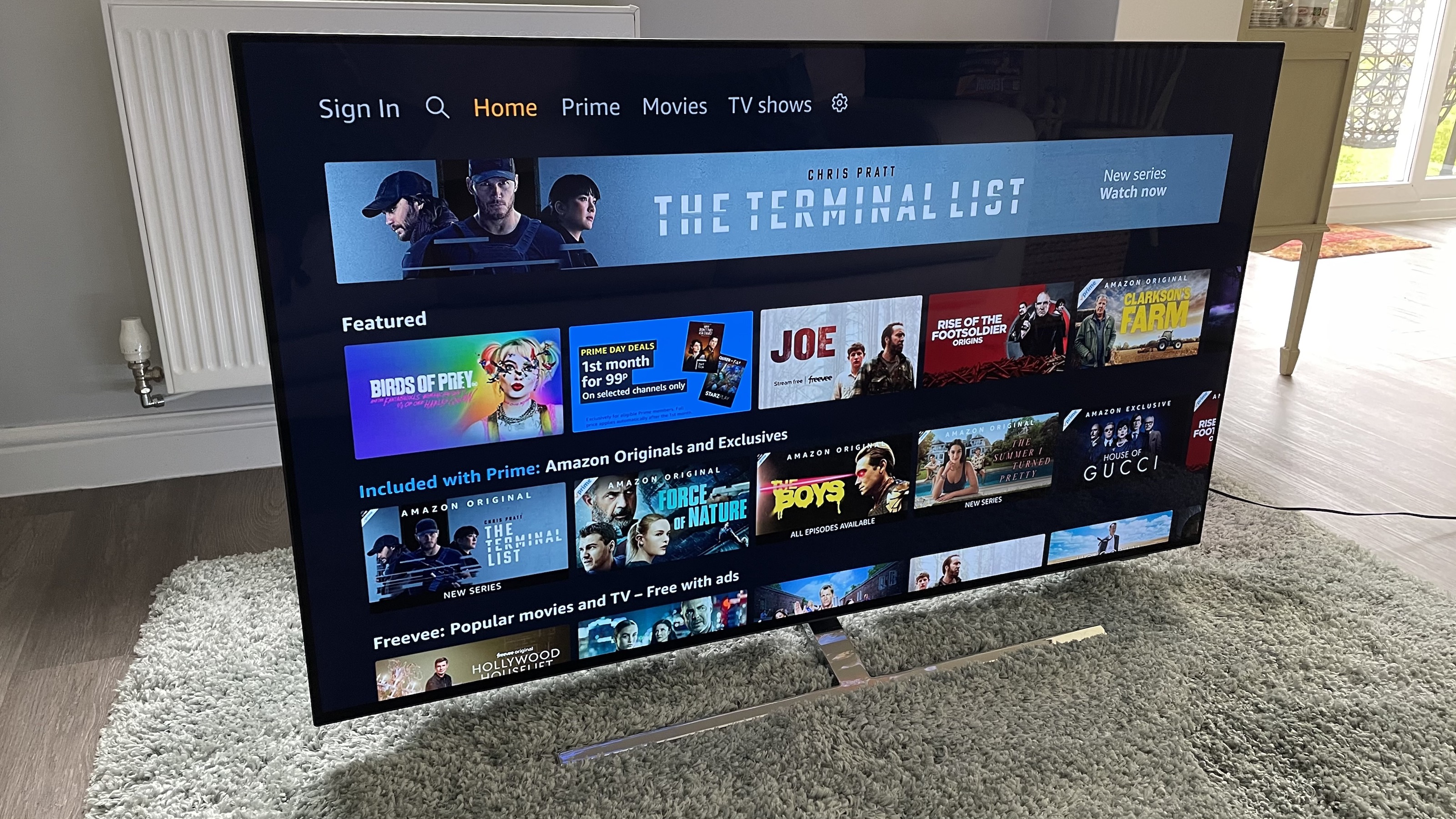
Philips OLED807 review: Picture quality
- Impressive brightness by OLED standards
- Vibrant colours
- Outstanding contrast and sharpness
Last year’s Philips OLED806 was up there with the very best mid-range OLED TVs – but the OLED807 beats its predecessor in pretty much every way.
The biggest step up comes from its brightness. We measured a decently sustained peak light output of nearly 870 nits on a white HDR window covering 10% of the 55-inch OLED807’s screen, which is around 100 nits up on the peak light output of the OLED806. This amounts to an almost 15% increase that can be keenly felt in both small bright highlights and full-screen brightness when watching HDR sources.
However, please note that the 48-inch OLED807 won't be able to match the same highs as this, because the panel can't get as bright at this size (it's the same for all 48-inch OLEDs) – this brightness applies to the 55-inch, 65-inch and 77-inch models.
The larger OLED807 models can therefore bring you more of the life-like impact and intensity that HDR is designed to deliver – with predictably gorgeous results. Especially as Philips has managed to find its new TV’s significant extra brightness without having to compromise on the fantastically rich, deep, neutral black colours that are pretty much the trademark of any quality OLED screen these days. Stars now twinkle with even more punch and clarity, for instance, against the darkness of space.
And because OLED’s self-illuminating pixels require (unlike even the best LCD TVs) no compromise to either the brightness of small bright highlights or the black levels of dark areas that may surround those small bright highlights, the impact of the OLED807’s extra brightness actually feels stronger than its measured 100-nit increase would suggest.
The extra brightness of the OLED807 filters, too, into its colour performance, helping to unlock an even more vivid look to pictures with most of its picture presets than we got with its already eye-catchingly vibrant predecessor.
Being able to deliver more native brightness means, too, that there’s a wider range of natural looking tones in the brightest parts of HDR images, as well as reducing the potential for clipping (lost shading) in peak light areas.
Crucially, outside of the spectacular but occasionally forced-looking Crystal Clear preset, there’s nothing gaudy or forced about the OLED807’s new brightness and colour achievements. The P5 processor deploys the extra capabilities of the new EX display with enough finesse and experience to ensure that it delivers nothing but positive outcomes.
The OLED807 retains Philips’ long-running reputation for sharpness, too. Its pictures look emphatically 4K with the set’s Ultra Resolution feature in play – and this feature now seems to cause no significant unwanted side effects, so we see no reason not to use it (we recommended avoiding it in the past). The OLED807’s extra brightness also brings out more shadow detail in dark areas than we got with the OLED806, and HD sources are upscaled with more sharpness and detail than you get from most rivals.
The sharpness isn’t messed up by camera pans or fast moving objects, either, thanks to Philips’ excellent motion compensation processing. The ‘Standard’ setting for this that’s the default for some picture presets is too aggressive, creating too much soap opera effect (excessive fluidity) and too many unwanted side effects. Its Pure Cinema and Movie settings, though, both offer excellent options for taking the edge off hardware judder without the image starting to look unnatural or uncinematic.
This need to change the default motion processing mode brings us to the fact that while the OLED807 is better out of the box than its predecessor, you should still get involved with its intimidatingly convoluted picture set up menus if you want to make sure you get the absolute best picture results. As well as the motion adjustments, all noise reduction should be turned off for the vast majority of native 4K and premium quality HD sources, for instance.
We also didn’t get on with the new Ambient AI modes, especially in the way they tend to make pictures look excessively dark, leading to a loss of shadow detail, if you’re watching the TV in a dark room. So you should turn these off.
We’d also recommend slightly reining in the sharpness and colour slightly with the Crystal Clear preset, while adding a touch more punch to the HDR Personal preset.
Philips can hardly be accused of failing to provide enough set up features, though, to help pretty much any buyer get the picture looking exactly as they want it to look.
- Picture quality score: 5/5
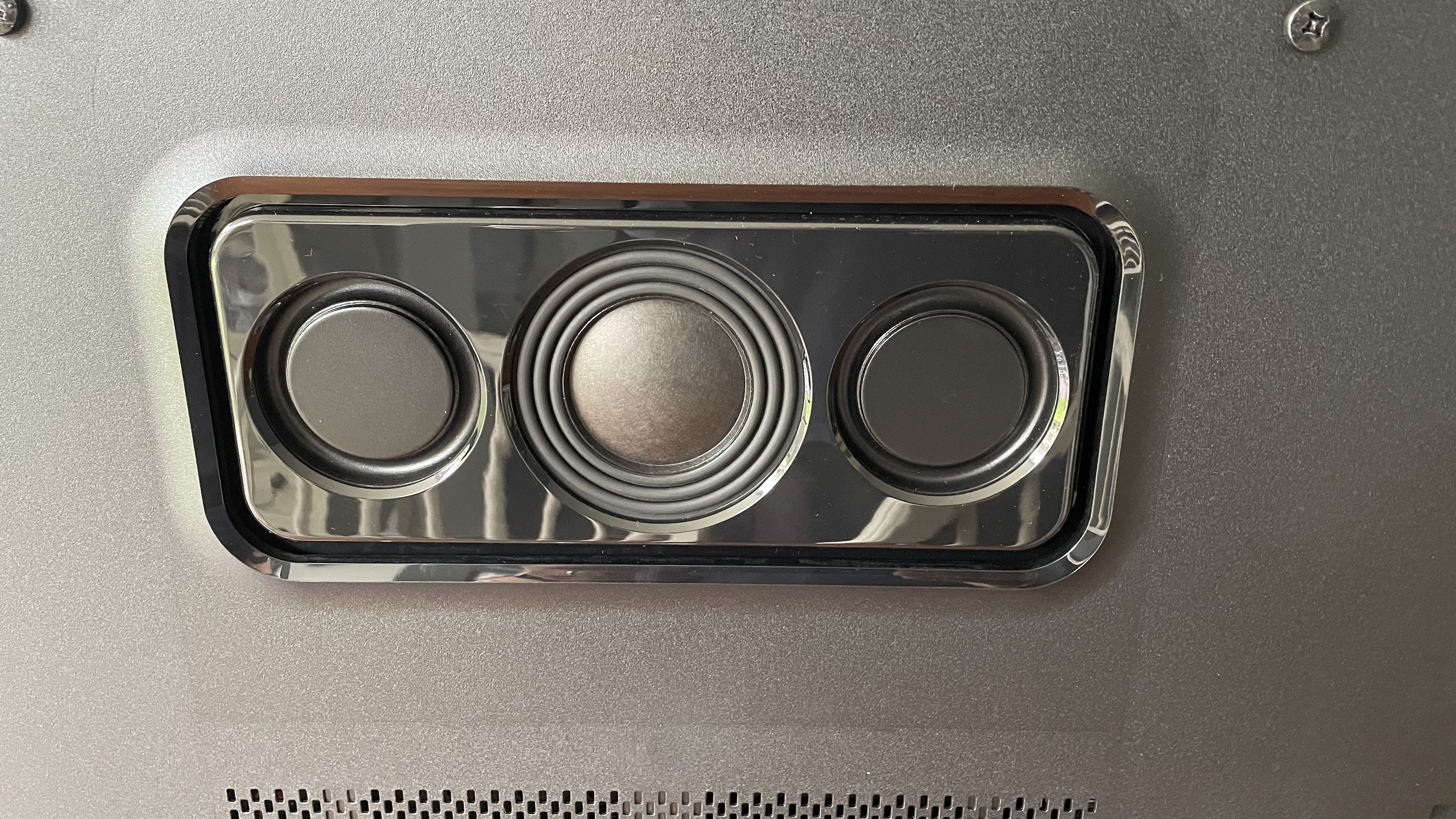
Philips OLED807 review: Sound quality
- Dolby Atmos support
- Powerful and open mid-range for such a skinny TV
- 70W of power in a 2.1 configuration
Precious few TVs at the OLED807’s price point carry a 70W audio system – never mind a 70W audio system with a dedicated bass speaker. It’s hardly surprising, then, to find that this Philips model sounds far better than the vast majority of other TVs in its class, despite the remarkable thinness that characterises much of its bodywork.
The set’s mid-range is wide and dynamic enough to deliver even dense action scenes with authority and conviction, easily avoiding the thin, hemmed in feel you get with big movie moments on so many TVs. The power and dynamic range that delivers this impressive mid-range performance also contributes to excellent detailing; a nicely projected sound stage that seems to exist well beyond the edges of the screen; and convincing, clear vocals.
The dedicated bass driver can’t quite avoid all buzzing and crackling disturbances with scenes that contain sustained basslines, but such breakdowns are pretty rare, and for the rest of the time the set benefits from a noticeably richer low frequency foundation than most TVs provide. It's absolutely one of the best TVs for sound at this price, though to be clear, you'd still need to add one of the best Dolby Atmos soundbars if you want a full home theater experience.
- Sound quality score: 4.5/5
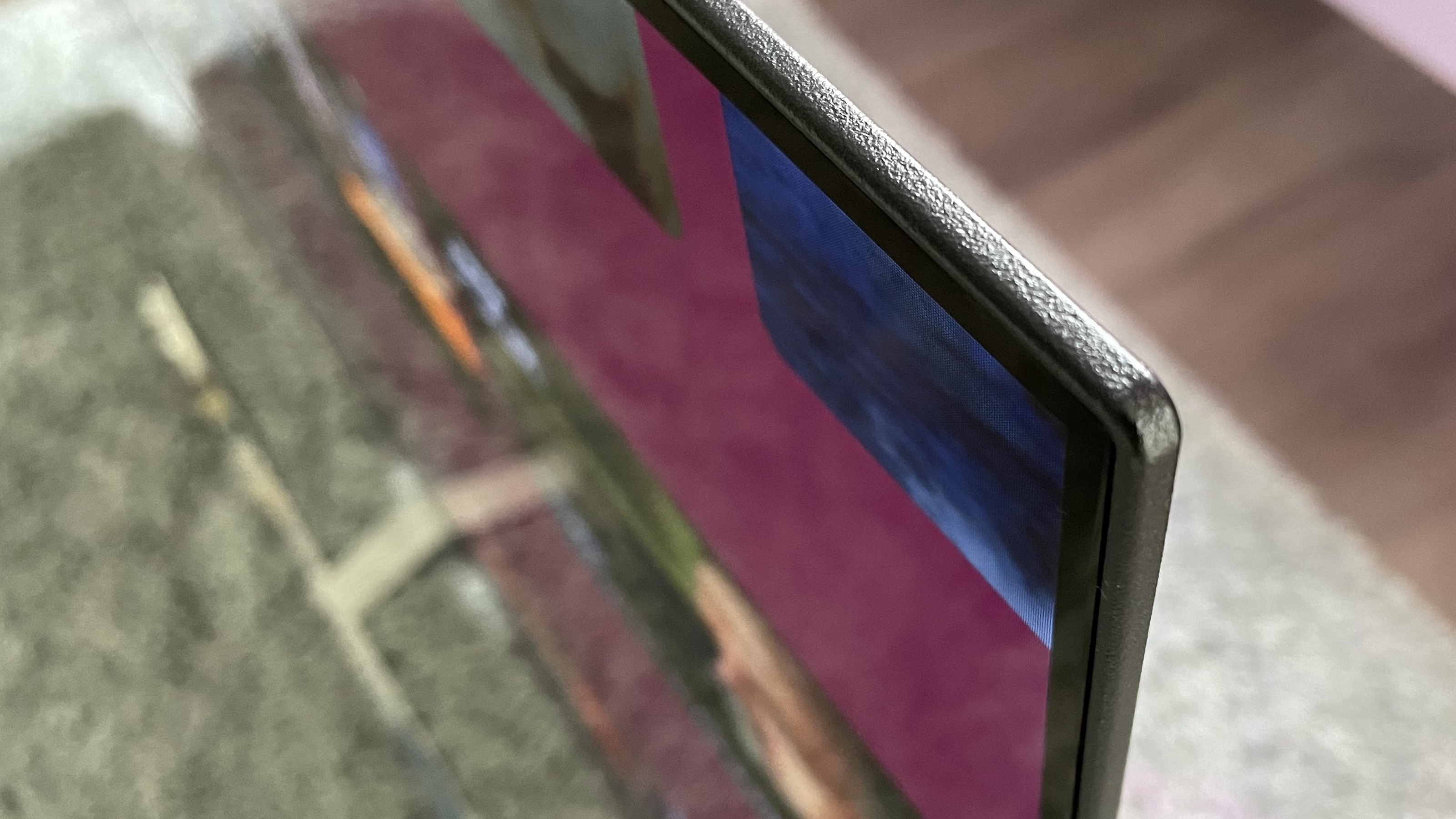
Philips OLED807 review: Design
- Ambilight works uncannily well
- Ultra-thin screen
- Distinctive polished T-bar stand design
The OLED807 is arguably the most flat-out glamorous TV in its class. For starters, it benefits from a four-sided version of Philips’ Ambilight technology, which throws out pools of coloured light onto the wall behind the TV. These colours can track the shade and placement of colours in the images you’re watching with startling accuracy, and Philips now provides an impressive array of adjustments to help you get Ambilight looking exactly as you want it to look.
A new Aurora feature even lets you combine Ambilight with a selection of ‘screen saver’ videos and images, ensuring that your TV could remain an attractive centrepiece to your living room even when you’re not actually watching it… assuming you don't mind the extra energy use.
The 55-inch OLED807’s spectacularly slim profile at its edges, beautifully finished metal backplate and strikingly shiny silver T-bar desktop stand make it one of the best looking TVs in town, too, even without Ambilight switched on.
The central portion of the OLED807’s rear sticks out much further than the screen does at its outer edges, but you don’t really feel this unless you’re watching the TV from a pretty severe angle. And in any case, if this slightly chunky central portion is the price you have to pay for the OLED807’s impressive sound, we’re more than happy to pay it.
- Design score: 4.5/5
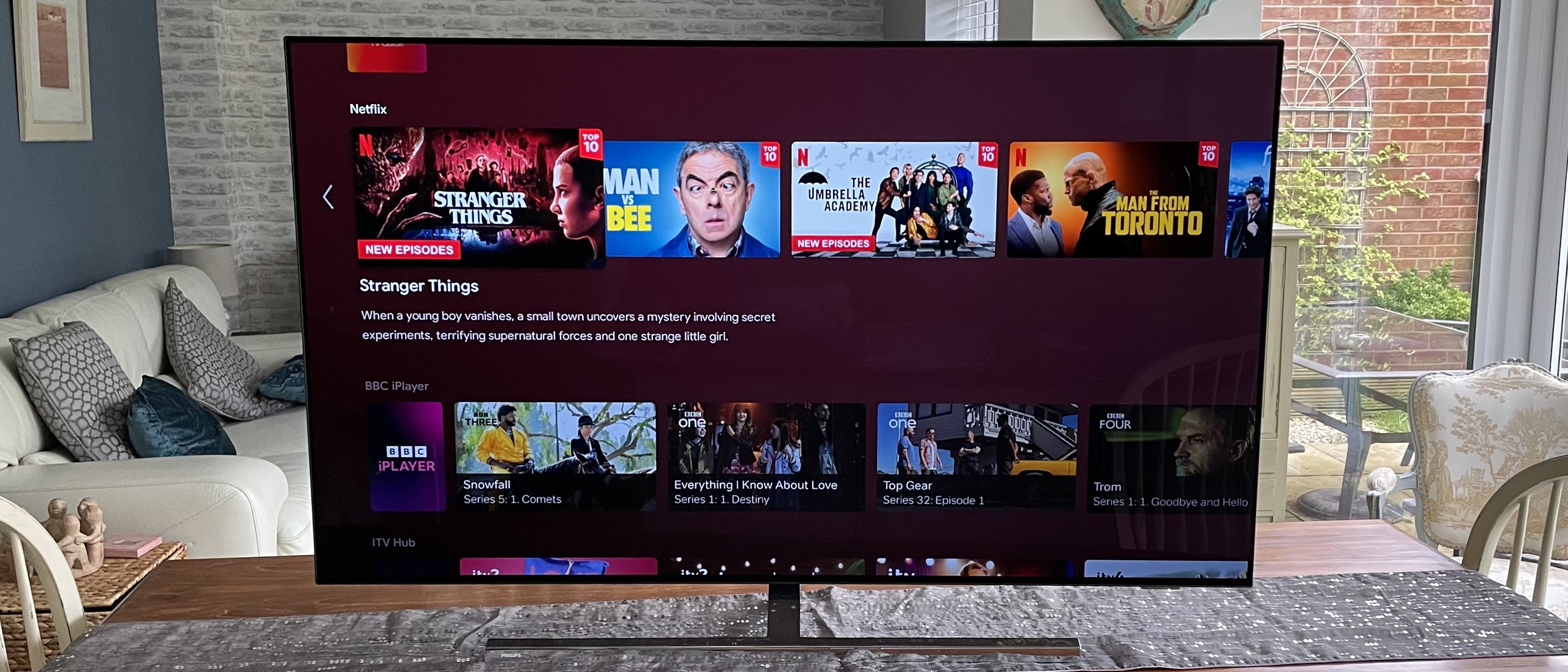
Philips OLED807 review: Smart TV & menus
- Android TV 11 smarts
- Very extensive set up menus
- Freeview Play provides support to Android TV
The OLED807’s smart features are provided by Android TV - the 11th generation of Android TV to be precise. This version of Android TV is far superior to any previous version in its presentation, stability and features, displaying a much greater understanding of how to deliver an interface that’s suited to TVs rather than personal smart devices. It’s still a little dictatorial and low on customisation options, but at least it no longer feels like it was designed to actively put you off using it.
It’s well-populated with content these days, too, with the likes of Apple TV Plus, Disney Plus, Prime Video, and Netflix all present and correct. It’s still missing the catch-up services for one or two of the UK’s main terrestrial broadcasters, but Philips has covered that by also equipping the OLED807 with the Freeview Play app, which brings all the UK’s catch-up apps together into one easy overall interface.
The OLED807’s set up menus, meanwhile, are best described as… exhaustive. Philips has tried to provide adjustments for almost every aspect of both general picture quality and the TV’s countless specific processing elements. This makes the menus extremely long and convoluted, though, and it doesn’t help that they’re packed with quite specific phraseology at times that most even relatively experienced AV fans won’t be familiar with.
This wouldn’t matter, of course, if you could just switch between picture presets and leave your involvement with the TV’s menus at that. As we’ve seen, though, consistently getting the best from the OLED807 means familiarising yourself with at least some parts of its picture adjustment menus.
- Smart TV & menus score: 3.5/5
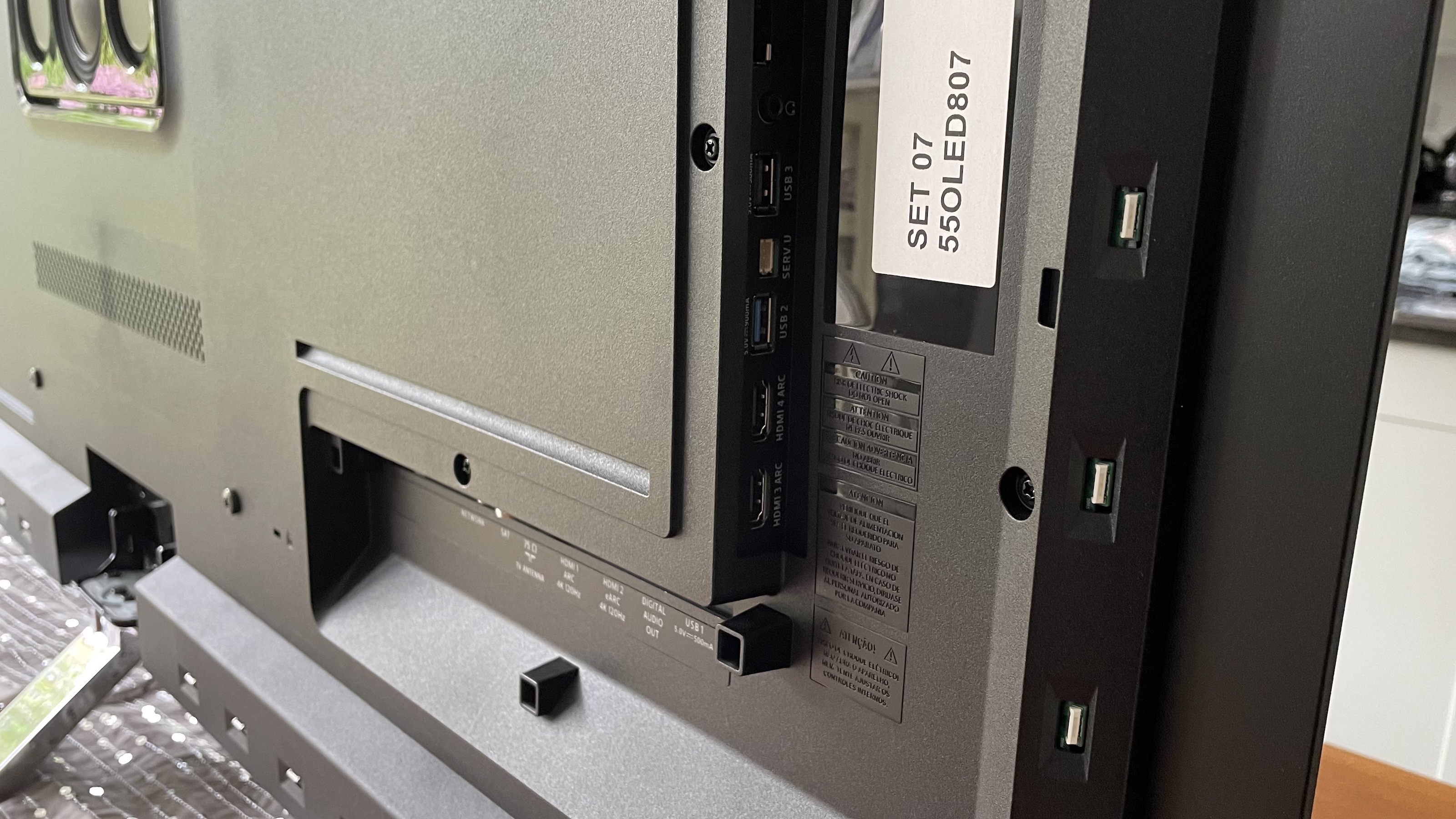
Philips OLED807 review: Gaming
- 4K 120Hz support
- Variable refresh rate support
- Dolby Vision game mode
Alongside the OLED807’s advanced video features lies an impressive suite of gaming support. Two of the TV’s four HDMIs are capable of supporting the full gaming house of 4K at 120Hz, automatic low latency mode switching, and variable refresh rates. The latter option extends to the AMD FreeSync Premium and Nvidia G-Sync varieties of VRR, too.
The set also carries a Dolby Vision Game mode (though this only supports DV up to 60Hz, not 120Hz like LG's OLEDs), and provided you select its Monitor setting the OLED807 can deliver 4K 120Hz without suffering the half vertical resolution issue that has affected some premium Philips TVs.
It’s a bit of a faff that you need to make sure the HDMI port you’re gaming on is set to its Optimal (Gaming) setting if you want to unlock all the TV’s gaming support, but most people will only need to check this once, I guess.
Philips also supports the HGiG system that lets you use set up menus built into your console to establish the best gaming HDR experience, rather than the TV trying to figure out on the fly how best to handle incoming HDR game graphics.
The key attributes of the OLED807’s video pictures – sharpness, contrast, colour and motion – also make it a superb gaming monitor. So long as you remember to check that you’ve got the right settings selected in the HDMI set up and picture preset menus.
Philips has got its Game preset input lag time down for the OLED807 to 15.1ms with 1080p/60Hz feeds. That’s still 5ms or so higher than the fastest results we’ve seen this year, but you’d have to be a more competitive gamer than us for 5ms to make a serious difference to your performance.
- Gaming score: 4.5/5
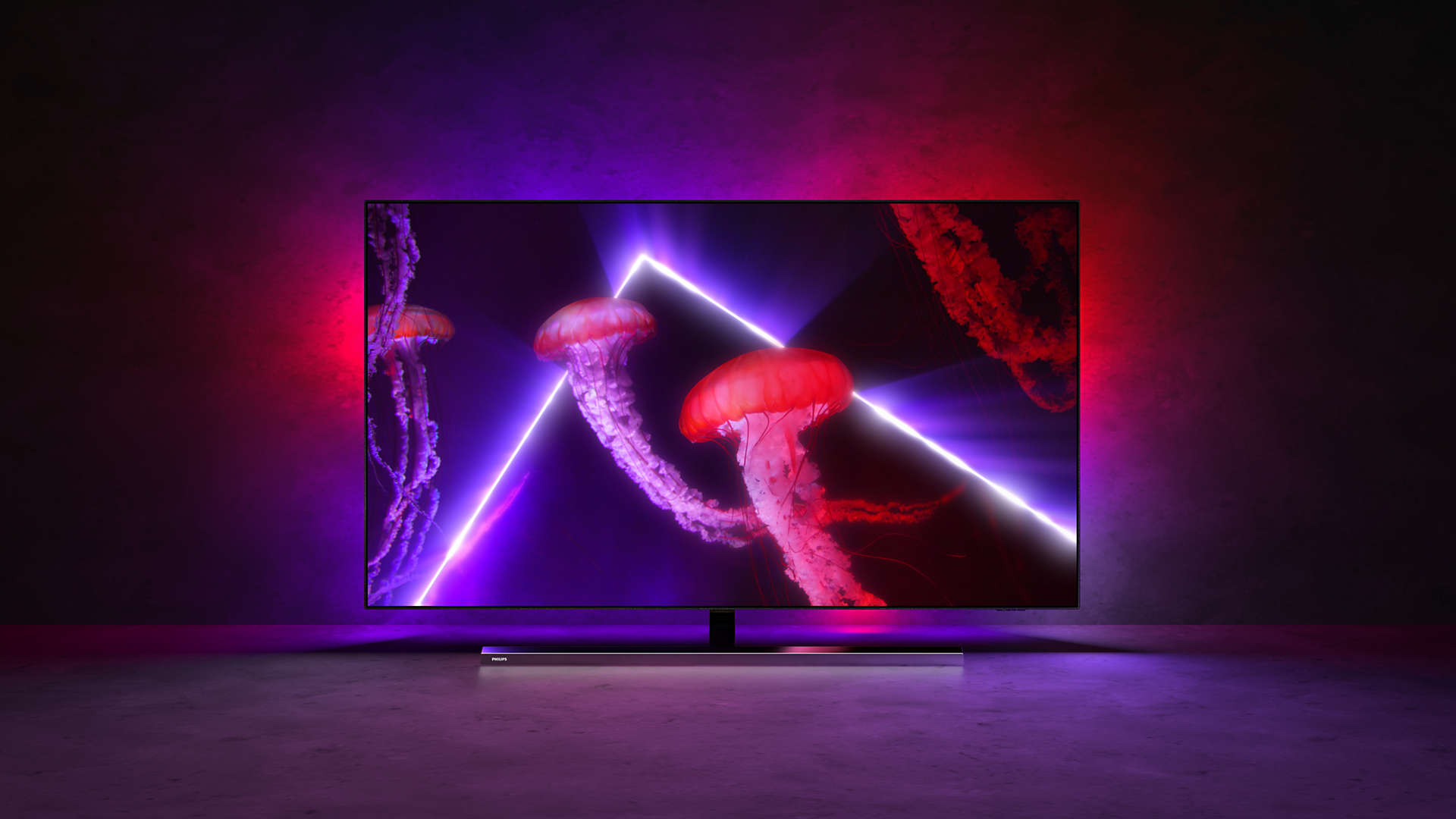
Philips OLED807 review: Value
- Priced to compete with LG’s C2 OLEDs
- Significantly cheaper than Philips’ step-up OLEDs
- Price seems very fair for what you get
The OLED807’s price is arguably the icing on the cake. Having to find just £1,299 at 55 inches for the level of picture and sound quality it delivers would have been enticing enough by itself, but in the OLED807’s case the value appeal is taken to another level by its extraordinary Ambilight-sporting design and premium build quality, its extensive gaming support, and its comprehensive smart TV features.
The Philips OLED807 certainly has a lot of competition this year - but we’d say it has more than enough unique qualities to stand out from the crowd.
There’s certainly nothing else out there that looks like it. From its super-sleek metallic sculpting to its immersion-boosting Ambilight system, it looks far more expensive than it actually is.
Its picture quality, meanwhile, takes a relatively aggressive approach that will win it many fans in both crowded electronics stores and living rooms – yet it also carries modes able to give you a more accurate picture if that’s your bag. Even its sound is way more powerful than that of most rivals.
- Value score: 4.5/5
Should you buy the Philips OLED807?
| Attributes | Notes | Rating |
|---|---|---|
| Features | Top-tier HDR support, great gaming features, and Ambilight. | 4.5/5 |
| Picture quality | Sharp, colourful and bright – shows the best of OLED. | 5/5 |
| Sound quality | 70W of power plus a sub is better than the competition. | 4.5/5 |
| Design | Very premium for a mid-tier price. | 4.5/5 |
| Smart TV and menus | Android TV has improved. The menus are deep… maybe too deep. | 3.5/5 |
| Gaming | All the key features are here, including Nvidia G-Sync. | 4.5/5 |
| Value | Very competitive with some of the best TVs around today. | 4.5/5 |
Buy it if…
You like the look of Ambilight
No other TV brand extends the viewing experience like Philips does with its Ambilight technology. The coloured lights spilling from the OLED807’s sides also make a great talking point at dinner parties.
You want a powerful all-round performance
Vibrant, punchy, contrast-rich and exceptionally sharp pictures are backed up by more expressive and dynamic audio than you’ll get from almost any other TV in its class.
Don't buy it if…
You hate fiddling
Getting the best from the OLED807 requires making a few tweaks to the picture presets via the TV’s intimidatingly extensive onscreen menus.
You have multiple cutting-edge gaming devices
Only two of the OLED807’s HDMIs support all the latest gaming features, and one is also the HDMI eARC port. Whereas all four of the HDMIs on the LG C2 or Samsung QN95B can handle features such as 4K 120Hz, VRR and ALLM.
Also consider
LG C2
LG’s long experience with OLED technology shines through with the C2’s beautifully refined pictures, while its aggressive pursuit of gamers has resulted in peerless gaming support. Its sound isn’t as powerful as that of the Philips model, though, and it's not as beautiful a design. And no Ambilight, of course.
Samsung S95B
Samsung’s debut Quantum Dot OLED TV is bright, colourful, incredibly sleekly designed and remarkably affordable for a brand new technology. But its pictures aren’t as refined as they are dazzling, and it doesn’t sound anywhere near as good as the Philips.
Sony A80K
This Sony OLED model is £200 more expensive than the OLED807 at 55 inches, and isn’t as vibrant or punchy with its pictures. Sony’s Cognitive XR processing gives pictures a beautifully refined and three-dimensional look, though, while its Acoustic Surface technology uses its screen as its speakers, resulting in a beautifully rounded and impactful sound that also places effects in the right place on your screen.
John has been writing about home entertainment technology for more than two decades - an especially impressive feat considering he still claims to only be 35 years old (yeah, right). In that time he’s reviewed hundreds if not thousands of TVs, projectors and speakers, and spent frankly far too long sitting by himself in a dark room.
